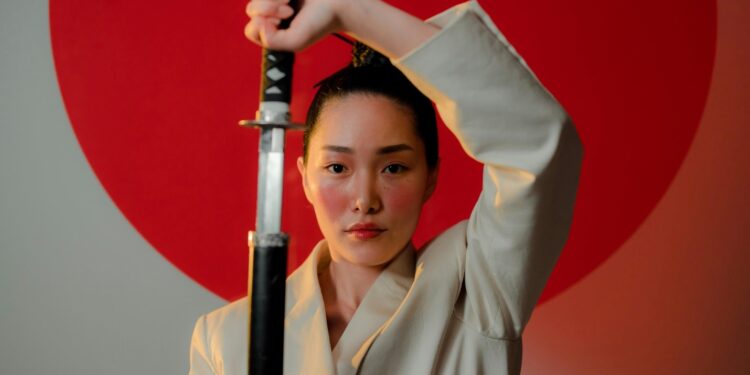Few weapons in the world hold the cultural and historical weight of the katana. Recognised for its distinctive curve, sharp edge, and deep connection to samurai tradition, the katana has become a symbol of honour, discipline, and craftsmanship. But where did this legendary sword come from, and how did it become such a defining image of Japanese history?
This blog explores the origins, evolution, and significance of the katana – and why it continues to capture the imagination of collectors, martial artists, and pop culture fans, especially through its presence in some of the most iconic fight scenes in anime and film.
Early Origins of the Katana
The katana as we know it today began to take shape in the late Heian period (794–1185), though its roots can be traced even earlier. Before the katana, Japanese warriors used straight-bladed swords such as the chokutō, influenced by Chinese and Korean designs. However, as mounted combat became more common, warriors needed a sword that could be drawn and used more quickly.
This led to the development of the tachi, a curved sword worn edge-down and suited for cavalry. Over time, swordsmiths began refining the curve and the metallurgy, eventually producing what would become the katana – a shorter, more practical blade that could be worn edge-up and drawn swiftly from the waist.
The Katana and the Rise of the Samurai
The katana came into its own during the Kamakura period (1185–1333), when the samurai class rose to prominence. This era saw frequent military conflict, and the need for strong, reliable swords was vital. The katana’s unique construction – typically using a combination of hard and soft steel folded repeatedly during forging – gave it both strength and flexibility.
This period also marked the rise of famous swordsmiths such as Masamune and Muramasa, whose blades are still revered today. A katana was more than a weapon. It was considered a reflection of the samurai’s soul, with each blade being carefully forged and often passed down through generations.
Craftsmanship and Symbolism
What sets the katana apart from other swords is its construction. Traditional Japanese sword-making involves folding steel many times to remove impurities and balance hardness with resilience. The result is a blade with a razor-sharp edge, a beautiful hamon (temper line), and excellent cutting ability.
But beyond function, the katana carried symbolic weight. It represented the virtues of bushidō – the samurai code of honour – including loyalty, courage, and self-discipline. The katana wasn’t simply a battlefield tool; it was an extension of a warrior’s values and identity.
Even today, authentic hand-forged katanas are highly respected and made by certified swordsmiths in Japan, often with strict adherence to centuries-old methods.
Evolution Through the Ages
As Japan entered the Edo period (1603–1868), the country experienced relative peace. With fewer battles to fight, the katana’s role began to shift. It became more of a status symbol than a weapon of war. Samurai still carried their swords, often in a paired set known as daishō – the katana (long sword) and wakizashi (short sword) – but swordsmanship began to focus more on discipline and personal development.
Later, during the Meiji Restoration in the late 19th century, samurai privileges were abolished, and public wearing of swords was banned. This led to a decline in sword-making, with many blades melted down or hidden.
However, interest in the katana never completely disappeared. It re-emerged in martial arts like kendō, iaido, and kenjutsu, and was eventually embraced again as part of Japan’s cultural heritage.
The Katana in Modern Pop Culture
Today, the katana is as much a pop culture icon as it is a historical weapon. It features prominently in films, anime, video games, and comic books. From legendary warriors like Hattori Hanzō to modern characters in series like Demon Slayer, Kill Bill, or Ghost of Tsushima, the katana has become a symbol of honour, skill, and precision.
This visibility has sparked renewed interest in iconic displays of the katana sword, whether for visual display, cosplay, or practice. Collectors often look for high-quality reproductions that reflect the detail and beauty of the originals, while martial artists may seek functional blades for controlled forms or cutting exercises.
What Makes a Katana Authentic?
While many replicas are available, not all are created equal. A true katana – even a modern one – requires precise balance, a proper heat-treated edge, and attention to the traditional shape and curve. Authenticity doesn’t just lie in appearance, but in the process behind it.
Collectors and enthusiasts often look for:
- Full tang construction for strength
- Proper curvature and weight balance
- Visible hamon lines from differential hardening
- Hand-forged or folded steel options (for higher-end models)
Whether for collecting or display, a well-crafted katana replica offers a connection to centuries of craftsmanship and tradition.
Why the Katana Endures
The katana isn’t just admired for its sharpness or appearance. It represents a blend of artistry and discipline that resonates with people across generations and cultures. Its survival through war, peace, political change, and modern media proves its lasting appeal.
More than just a sword, the katana tells a story. A story of warriors who valued honour above all else. A story of craftsmanship passed from master to apprentice. A story of a nation’s cultural pride.
For many, owning a replica katana is not just about having a beautiful item on the wall – it’s about appreciating a piece of history that continues to inspire.
Final Thoughts
The katana remains one of Japan’s most iconic and respected blades. From its early beginnings on the battlefield to its role in modern storytelling, this sword has stood the test of time. Whether you’re a martial artist, history fan, or anime collector, understanding the legacy behind the katana adds depth to your appreciation of it.
If you’re considering a replica for your home, cosplay, or collection, take a moment to reflect on the centuries of tradition behind its shape and shine. The katana may be forged in steel, but its impact is felt far beyond the forge.













